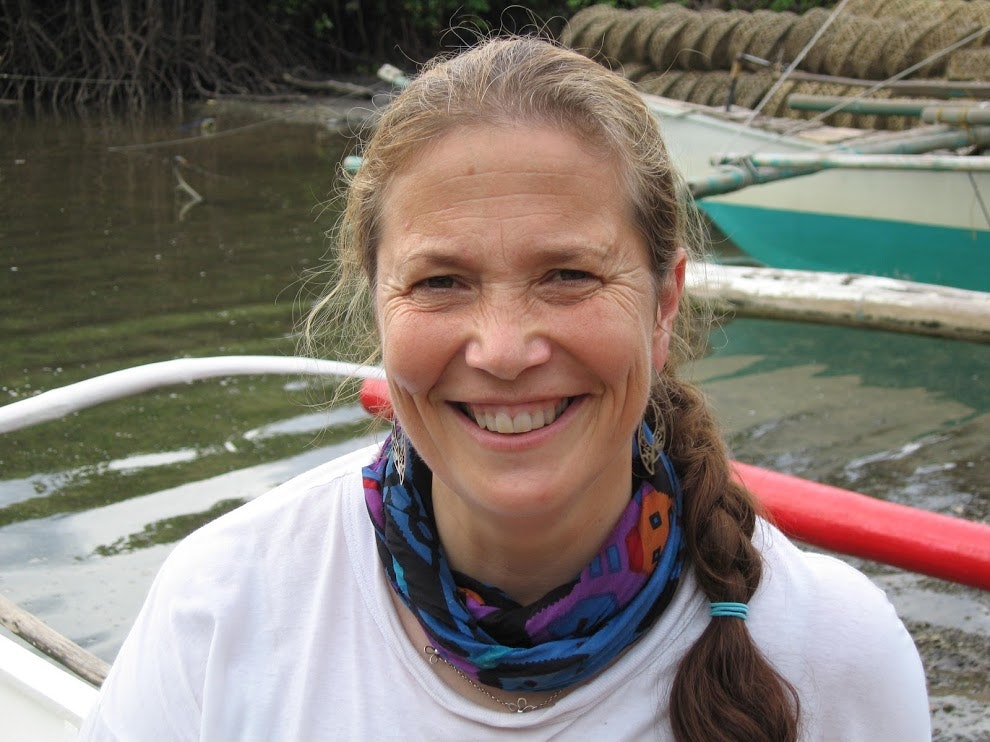Project Seahorse, Philippines
The first ever Whitley Award was given to Dr Amanda Vincent for an extensive study of the biology and conservation of seahorses.
The Canadian-born marine biologist, based at Oxford University, had already studied seahorses and the closely related pipefish in Sweden, Florida, the Caribbean and Australia. Amanda was the first person to study seahorses in the wild and had spent much of her time under water with these creatures.
Amanda’s pilot study in Asia originally revealed that tens of millions of seahorses are killed globally each year. They are being exploited globally as Chinese medicines, aphrodisiacs, aquarium fishes, food and curios. China’s economic boom has created a soaring demand for dried seahorses and these are now being traded by at least 20 countries.

The scale of such exploitation has raised serious conservation concerns because important marine habitats often get damaged and because the current harvest is likely to deplete future seahorse populations; many seahorse collectors were already reporting declining catches to Amanda.
On winning the award, she said, “The Whitley Award will enable me to collaborate with Asian partners in order to study the basic biology of exploited seahorse populations and to assess the conservation implications of the trade. Possible future options include establishing some level of protection for the seahorses, promoting seahorse agriculture, and/or modifying fishing practices. Given their huge popular appeal, seahorses should be valuable flagship species for protecting their vulnerable seagrass, mangrove and reef habitats.”

“All our biological knowledge will be necessary to ensure the survival of seahorses; they are particularly fascinating creatures in that only the male becomes pregnant. The female transfers eggs to the male’s brood pouch where they are fertilized, protected and regulated, and provided with oxygen and nourishment. After several weeks the male goes into labour to release his independent young. Males are always pregnant during the breeding season because they re-mate within a day or two of giving birth.”
“My Australian study of tagged seahorses – the first study on wild seahorses – showed that they are remarkable for their sexual fidelity. The same males and female seahorses mate only with each other, and reinforce their pair bond with daily greeting dances. Early each morning the female moves to her partner, both brighten and they dance together for six minutes before separating for the rest of the day. Greetings continue throughout the male’s pregnancy and are then elaborated into nine hour courtships. Seahorses obviously recognise each other as individuals because they ignore non partners. Surprisingly males compete more to obtain a partner than females do, even though the result is pregnancy.”
Throwing a lifeline to this endangered species, the first Whitley Award enabled Amanda to set up new marine reserves and survey the state of seahorses across southeast Asia, from China, India, Indonesia, Vietnam and Thailand to the Philippines.
PROJECT UPDATES
Since winning her Whitley Award in 1994, Amanda has helped Project Seahorse develop into a truly international and interdisciplinary organisation committed to conservation and sustainable use of the world’s coastal marine ecosystems. Project Seahorse conducts research and management at all scales, ranging from community initiatives to international accords, and, collaborating with both stakeholders and project partners, uses the seahorse as a focus for creating wider marine conservation solutions.
In 2005, Amanda gained further recognition of her outstanding contribution to marine conservation through winning the Chevron Conservation Award.
2024 CONTINUATION FUNDING
National action plan for Seahorses
Philippines
£90,000 over 2 years
Since winning the first-ever Whitley Award more than 30 years ago, Amanda has spent the last three decades developing Project Seahorse into a truly international and interdisciplinary organisation committed to conservation and sustainable use of the world’s coastal marine ecosystems.
With support from WFN funding, she has used the species as a focus for creating wider marine conservation solutions in the central Philippines, establishing 35 no-take marine protected areas (MPAs) that are locally developed, managed and enforced, and has overcome fierce opposition to see seahorses listed under the CITES (Convention on International Trade in Endangered Species) Appendix II list of regulated species – a precedent-setting move that paved the way for the regulation of other marine species, most notably exports of sharks and rays.
On invitation from the Philippine government’s Bureau of Fisheries and Aquatic Resources (BFAR), Amanda and her team will now use Continuation Funding to expand their longstanding regional work to a national scale by implementing a National Action Plan to improve the conservation status of seahorses. With seven of the Philippines’s 10 seahorse species listed on the IUCN Red List as globally threatened and three as Data Deficient, she hopes to improve understanding of seahorses, using the IUCN National Red List Assessment Tool.
Seahorses are threatened by overexploitation, poor fishing practices, and habitat degradation. By conducting research and management at all levels, from community initiatives (such as establishing a self-sustaining network of seahorse advocates who monitor sentinel seahorse populations) to international accords, Amanda hopes to create self-sustaining initiatives with robust monitoring that strengthen marine protected areas (MPAs), enhance enforcement of fisheries regulations, and move toward sustainability in wildlife trade.



